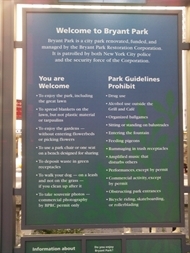
Bryant Park's outdoor reading room
This spring I attended the Project for Public Spaces Making It Happen training in New York City. Professionals from around the world dedicated three days to explore ways to create better places in the communities where they work and live. A theme that resonated with me is the idea that, particularly in public spaces, chaos creates opportunity. A layering of activities draws a variety of people to a spot. This got me thinking about the Chicago Loop Alliance’s plans for Pritzker Park.
Currently used more for a pass-through than a destination, Pritzker Park is full of untapped potential. But, located amidst the flagship Harold Washington Library, a handful of universities and the El, the park has all the prerequisites to create that chaos and opportunity inherent in beloved public places. With Chicago Loop Alliance’s recent curatorial ownership, the park will take on a new life this summer.
A field trip to New York’s Bryant Park helped to underscore some ideas that are absolutely applicable to some of our underperforming parks in Chicago—Pritzker Park included.
Bryant Park provides living proof that a variety of activities—from programmed performances to something as simple as people-watching—help to attract more people, yielding an overall vibrancy that only human interaction can create. The biggest lessons are:
-
Activities and opportunities for interaction. Bryant Park has a number of things to do in every corner: a carousel, bocce, movable tables and chairs, bird watching, people watching, checkers, meetings, outdoor book rooms, ping pong and dining—the list goes on.
-
Moveable chairs. William Whyte describes this phenomenon in The Social Life of Small Urban Spaces: people like to have control over where they sit—even if it means moving their chairs just one inch. Skip the bench seating. As Whyte quips in his book, the primary benefit of fixed seating is to “punctuate architectural photographs.”
- A welcoming atmosphere. Signage notifies visitors of programmed activities and starts with what they CAN do at the park, rather than what they cannot.
-

thesocietypages.com
- Programming. Provide regularly programmed events that people can grow to expect. A one-time event may not draw a strong crowd, but a series would. Tap into Chicago’s cultural amenities to draw attention.
While not every park or public space will be as robust as Bryant Park, we still have the capability of creating vibrant parks and plazas that offer a variety of uses to attract people of all ages. Placemaking is all about infinite possibilities and layers of public engagement that complement and build on each other. Let’s make Chicago’s Pritzker Park a study in the opportunities of well-crafted chaos.
Do you have great ideas on how to activate Pritzker Park? We’d love to hear them—please leave your comments below!